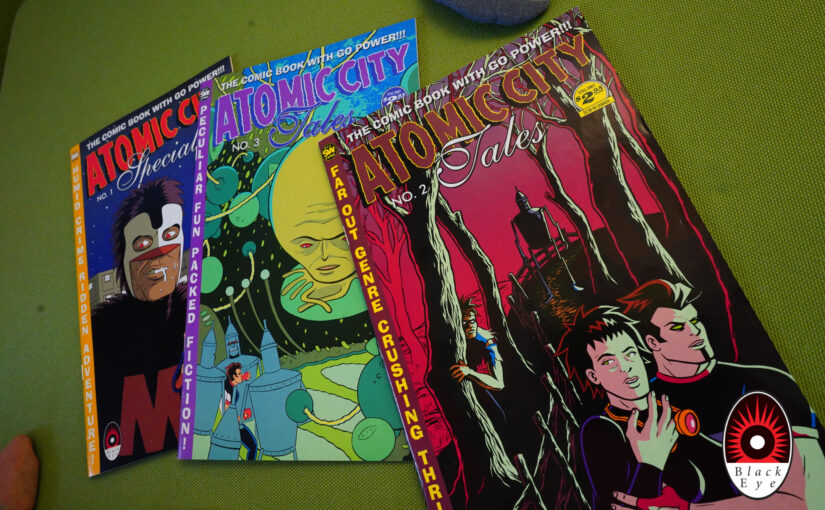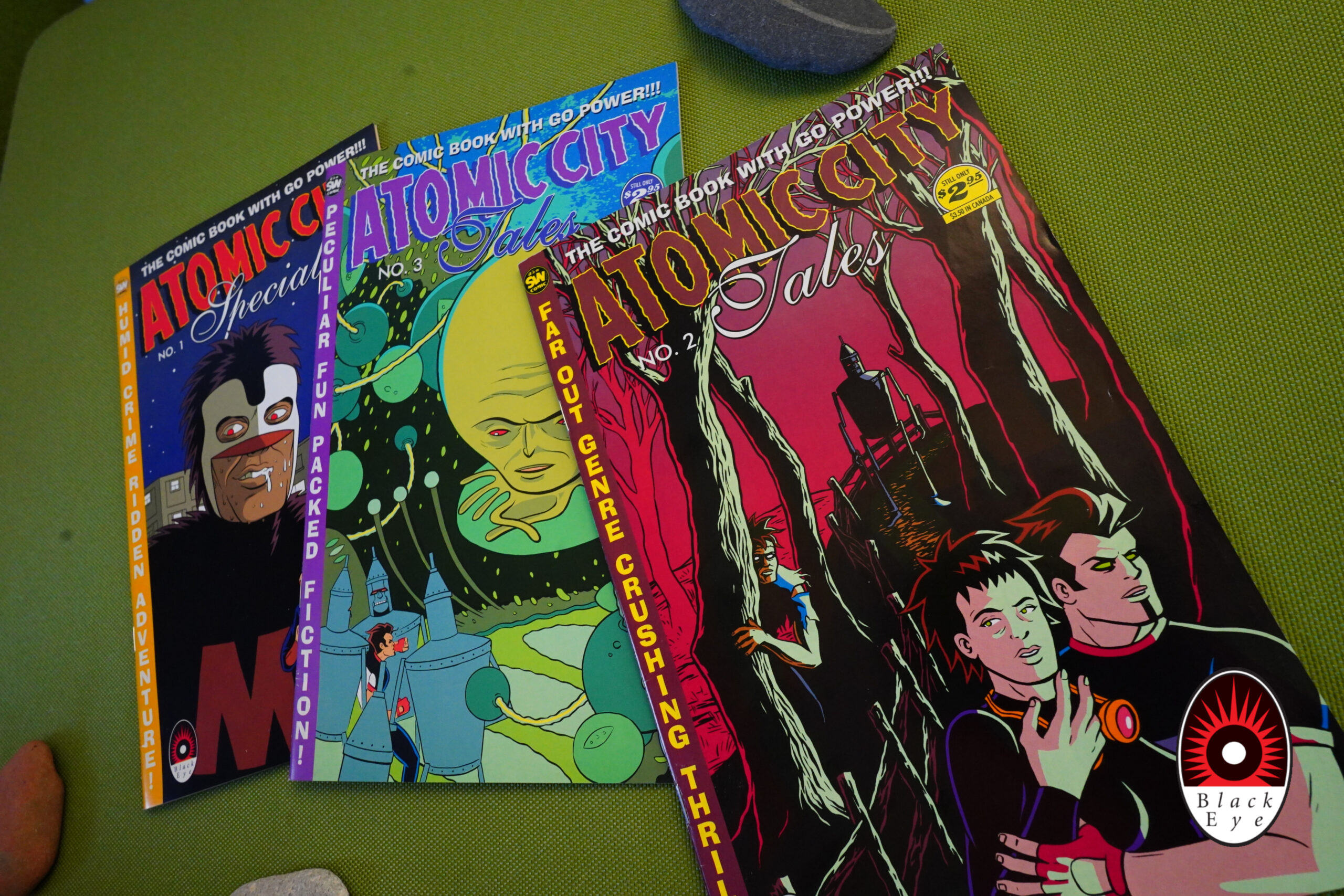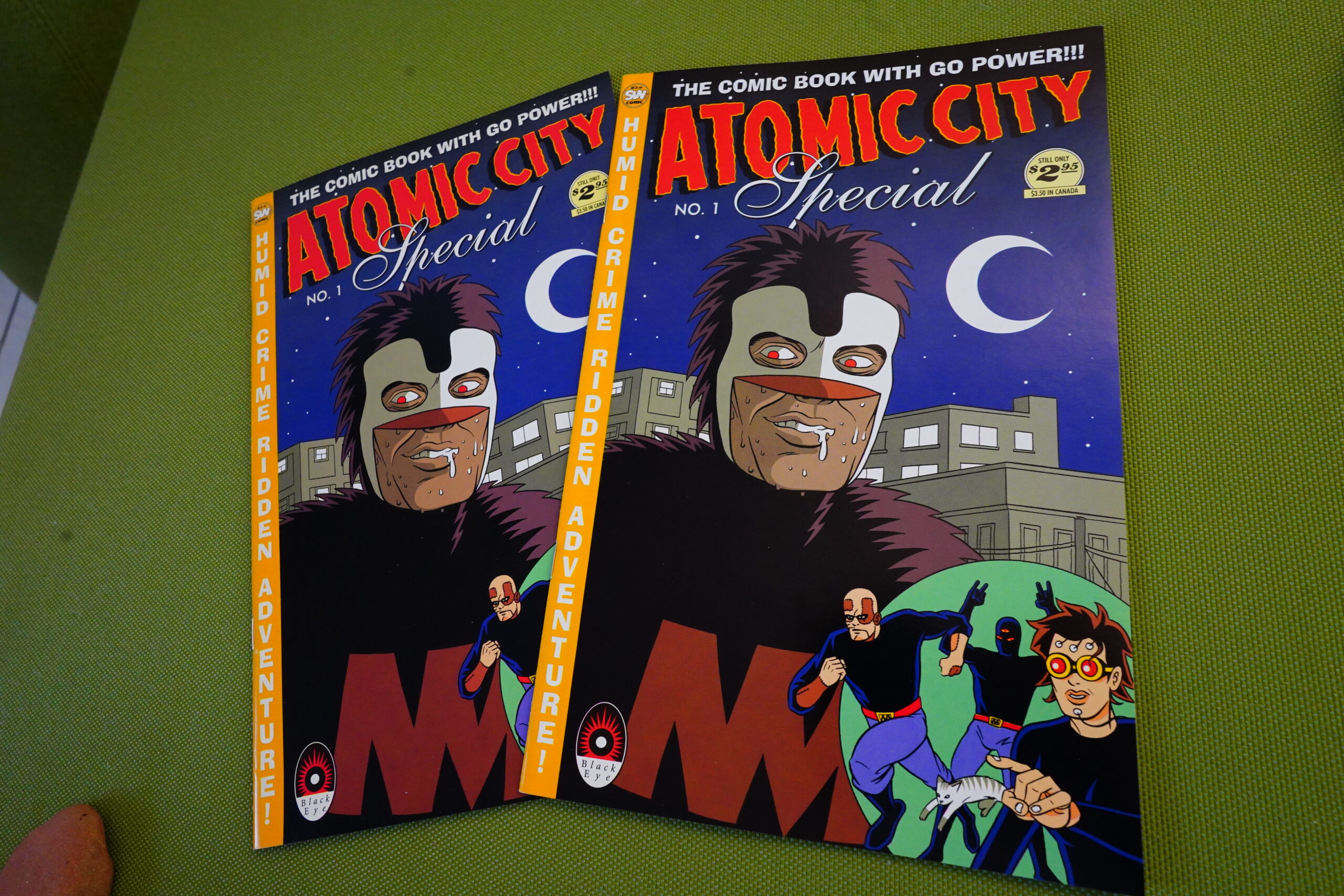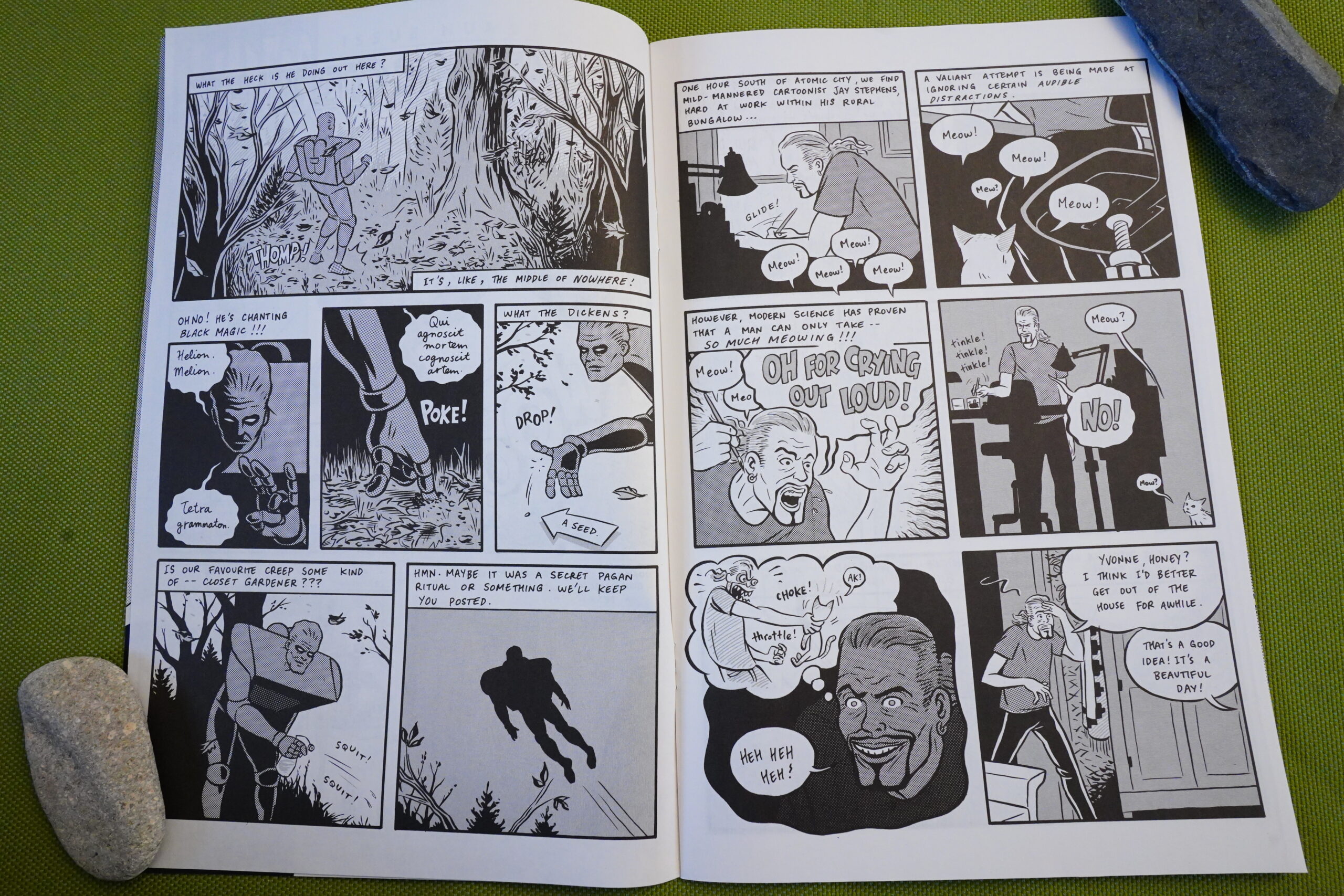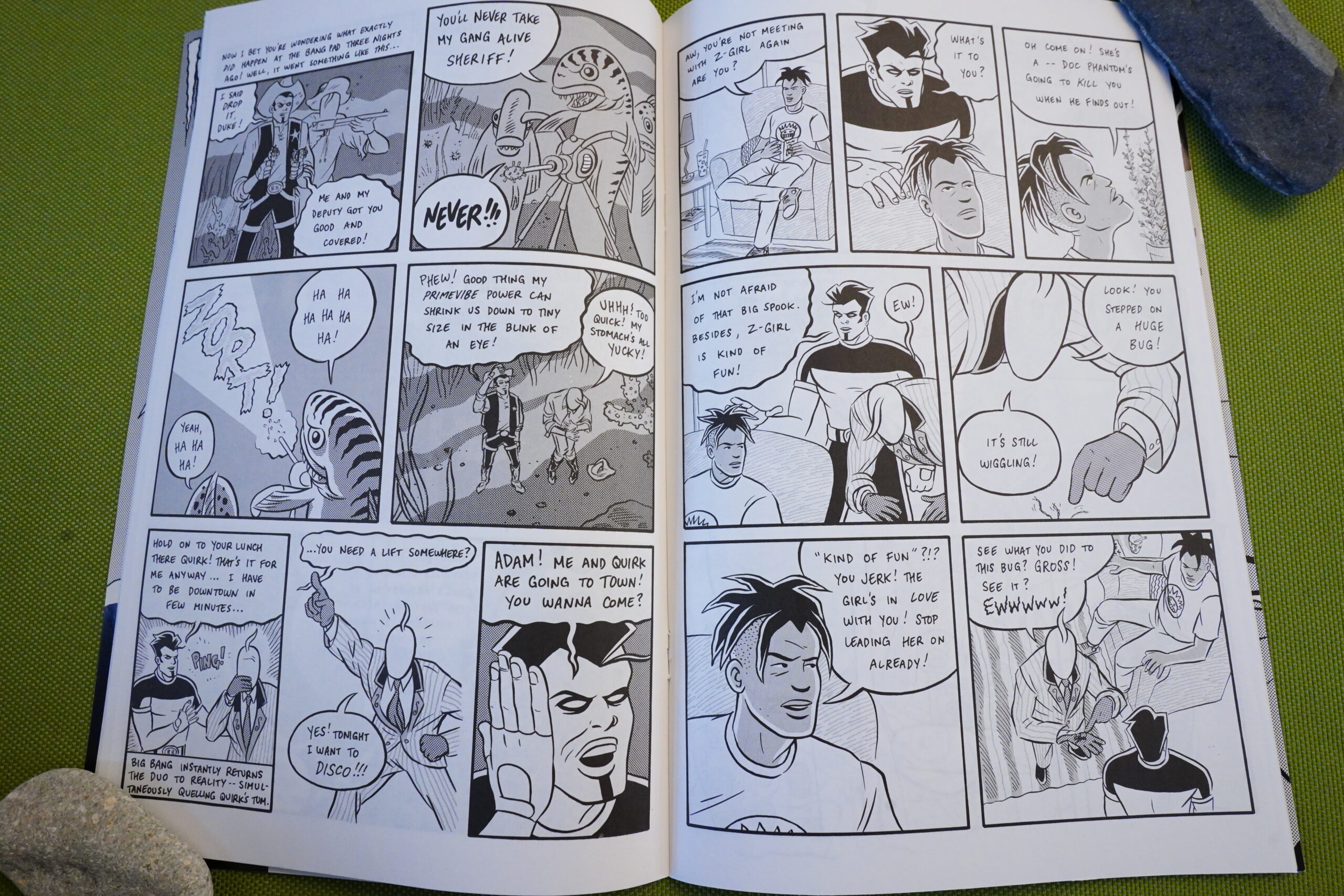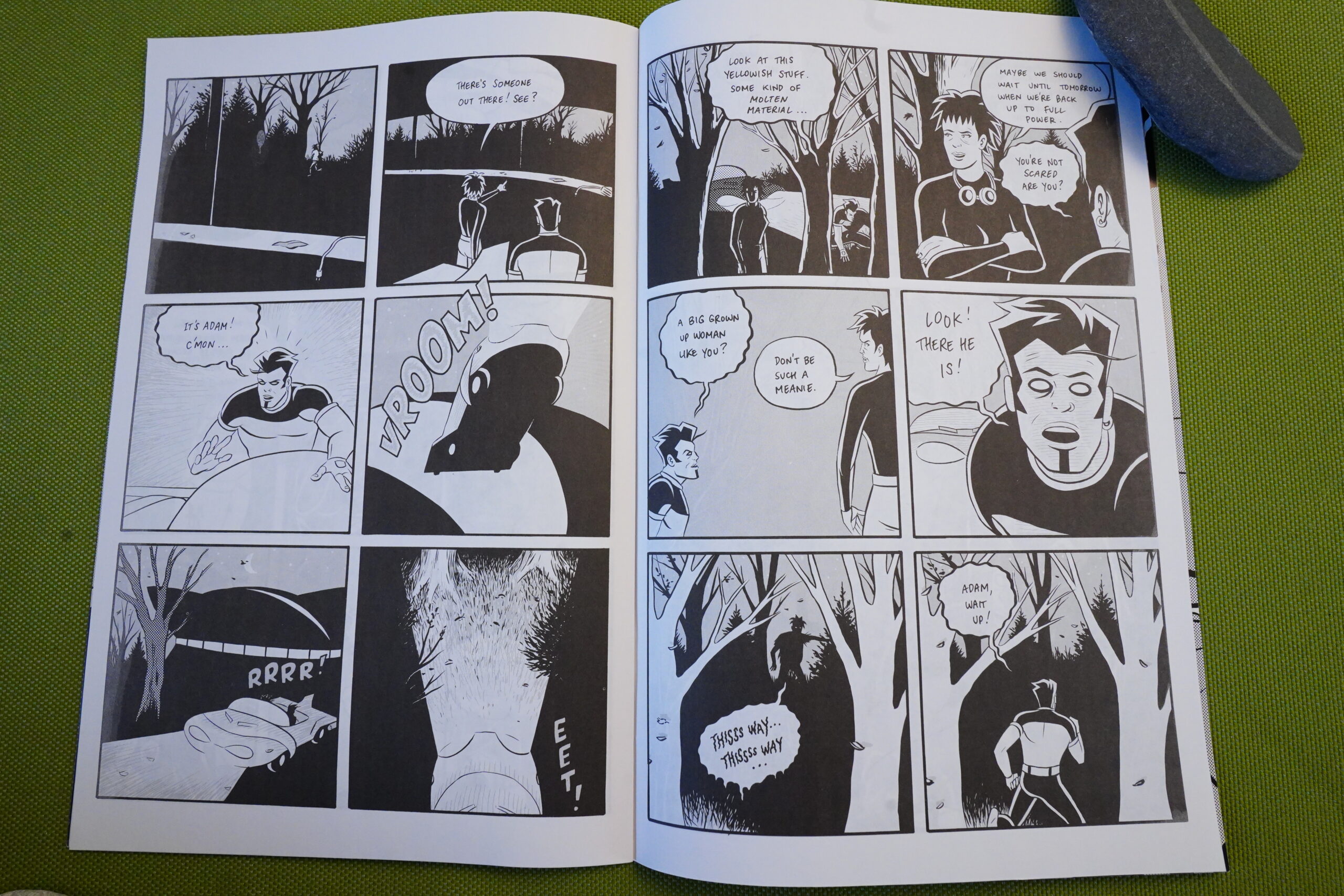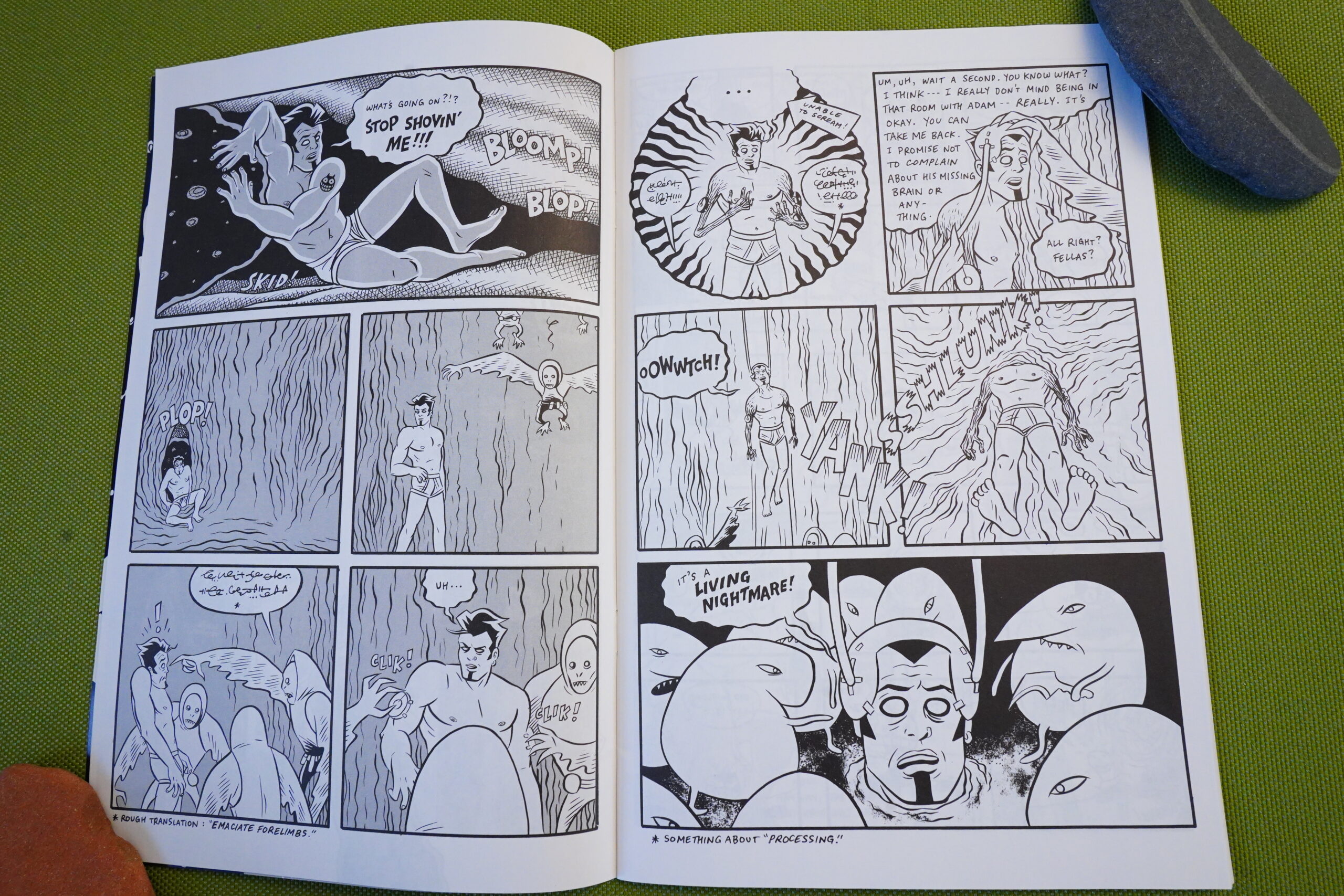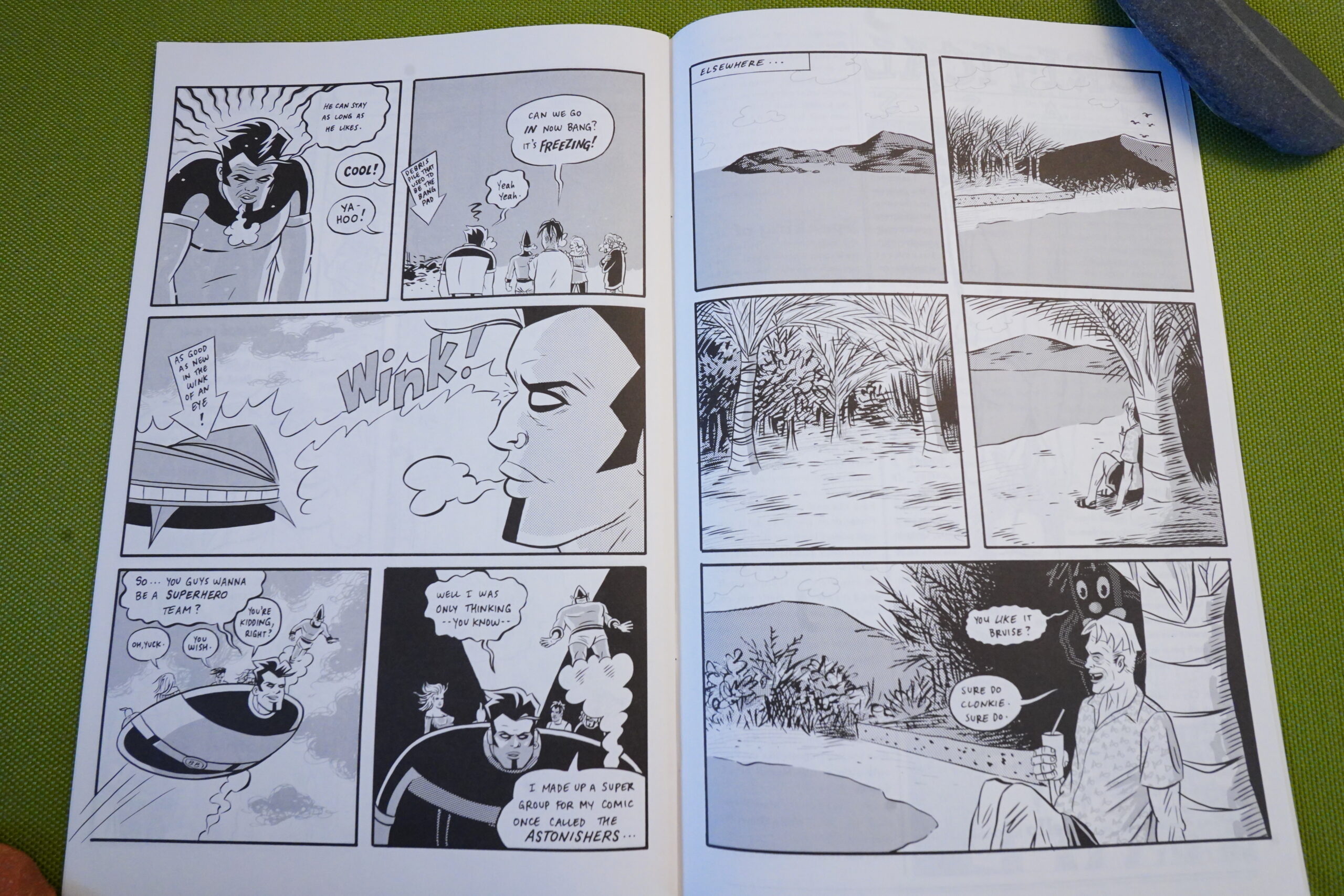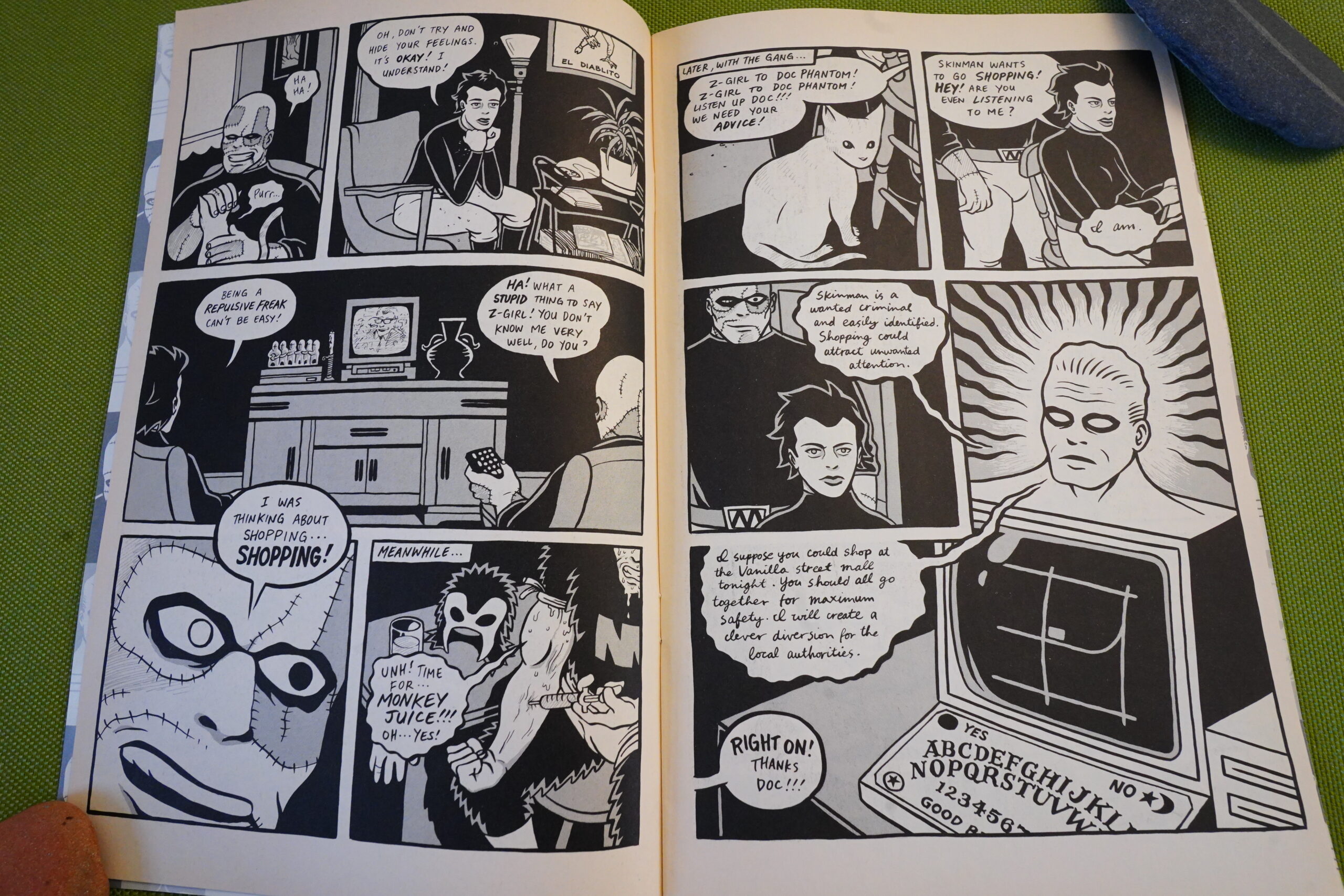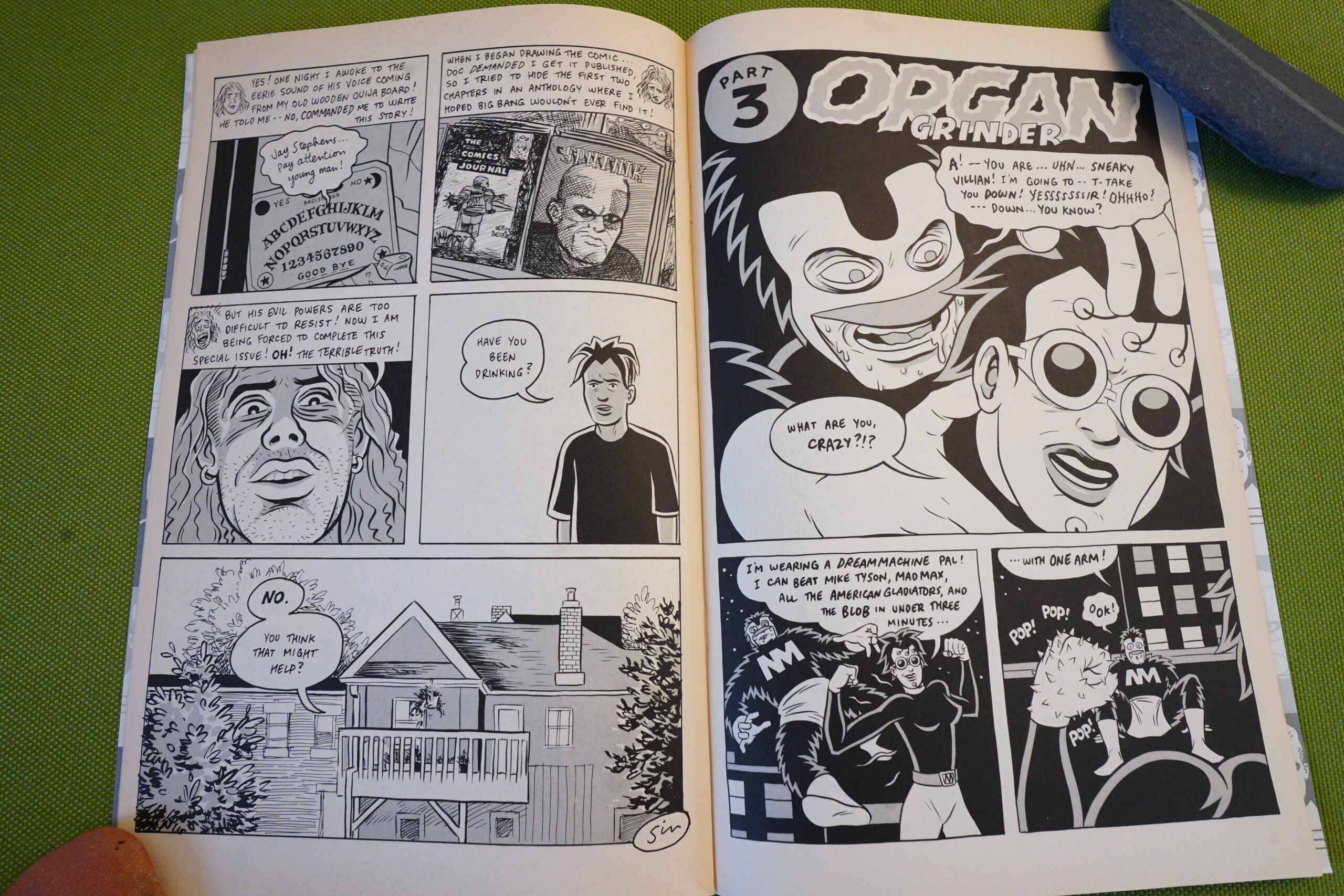Atomic City Tales (1994) #1-3,
Atomic City Special (1995) #1 by Jay Stephens
Oops! I messed up. I have to copies of Atomic City Special #1, but no copies of Atomic City Comics #1. So this blog series is going to be less than complete, but I’m not fixing that, because I already covered this material over on the Kitchen Sink blog.
So there.
Instead let’s have a look at the three issues I do have.
From the sounds of the editorial, it seems like people have been going “we liked your earlier, funnier stuff better” at Stephens? And I can indeed understand people being disappointed at not getting more comics in the vein of the original Sin series, because that thing was a lot of fun.
This series concentrates on the super-hero parody/pastiche/whatever that Stephens had started in Sin Comics, so it’s a lot more straight forward. But when I say “concentrates”, that’s not really saying all that much when it comics to Stephens: We’re still talking basically stream of consciousness plotting.
Which I’m a fan of — I like gags, and Stephens puts a lot of them in here, too — but it’s also frustrating, because when Stephens drops in these scenes of “serious plotting”, you already know that it’s not going to go anywhere.
(Is that woman up there inspired by Kim Deitch, by any chance?)
It’s loopy and it’s fun, and it’s less Flaming Carrot than it used to be? Now it’s more Zippy.
It’s also fun to just look at Stephens’ artwork — I mean, he was always good, but he’s getting more and more stylish. That’s a nice spread to just contemplate. Some of those panels are giving early Jamie Hernandez.
Yeah, the letters pages are all “godd, but Sin? that’s was great” vibes.
Heh, that’s a good nightmarish sequence.
And the storyline (as you might kinda call it) sort of wraps up in the third issue, but not in a very… intentional way? These are the last two pages. So it’s hard to say whether Stephens knew that this was the end of the series or not.
Because the issue mentions the Special:
And the special reprints the two chapters that appeared in Sputnik magazine.
But adds a final third chapter to wrap up the story, so that’s nice.
I have to say that I liked reading these comics better than I liked reading the collection, for some reason or other. In the collection the aimlessness was more of a problem than here, somehow.
Wizard Magazine #37, page #118:
NOt many comic creators take chances like Jay Stephens. After finally finding
a comfortable home for the “anything goes” format of Sin Comics, Stephens
hos decided to drop everything and start Atomic City Toles, new comic that
features, of all things, superheroes! For mo$t artists, a switch to superhero comics would
equal a rise in sales, but Stephens runs the risk of alienating the fans who have grown
accustomed to his wacky, irreverent humor and offbeat funny-animal characters.
Stephens started off in minicomics and graduated to Sin, a full-sized comic published
by the late Tragedy Strikes Press, Sin featured Stephens’s bizarre creations, including Nod,
Irwin. and Dave, who were simplified, abstracted versions of Felix the Cat, Mickey Mouse,
and Donald Duck. Just after picking up steam and gelling five issues Of Sin published,
tragedy struck and Tragedy Strikes disappeared from the face of the planel bringing
Stephens’s comic to an abrupt end. IA sixth issue was completed, but it hos never seen print.}
Luckily, some of the loose ends from the company were picked up when former Tragedy
Strikes editor Michel Vr6no started Black Eye Productions, the publisher behind most Of
Stephen’s current work, Black Eye put out issues of the new and improved Sin Comics
before Stephens replaced it with Atomic City Tales.
Stephens’s neve’ superhero work seems to be more of an evolution than an abrupt shift
of direction, The original version of Sin featured the Sinister Horde, who starred in c
superhero strip ran alongside Stephens’s quirky Land of Nod stories, as well as the
adventures of Badman, a crime fighter who was actually a thinly disguised Joy Stephens.
When the new Sin Comics series debuted* Stephens killed Off most Of his funnyonimol char-
acters to make room for superhero comics that prefigured the characters in Atomic City
Tales. EVen the wacky characters in Sin and Sin Comics, like Stephens himselfi were fans
of cheesy comic
In fact, Atomic City Tales has the same humor
and many of the unexpected twists that are trades
mark of Stephens’s work. In Atomic City Toles,
Stephens has created o comiC that doesn’t neatly fit
into one specific genre, isn’t really an “alternative”
comic because it’s about superheroes, It can’t be o
modern superhero comic because it isnit ogrim and
gritty,” It’s not like the musty and moldy retro-super-
hero comics because the characters and situations are
ypdoted and distorted with a ’90s bite.
The Comics Journal #212, page #92:
ATOMIC CITY FAILS
SULLIVAN: Let’s talk a little bit about Atomic
City Tales.
STEMNS: I know you don’t like it. [laughs]
SULLIVAN: I like it.
STE*ENS: I like to tease you al»ut that review,
SULLIVAN: It was a positive review.
STEMNS: I know. It was just a very qualified
review. good, but — [laughs] I We seen
SIRLIVAN: Nou I understand that you had all
these outlets for the funny characters that I love,
even though couldn see any Of them.
STEPHENS: If I could do everything at once, I
SIRLIVAN: Butyour letters pages in Atomic City
Tales •were hysterical. You wouldthink in a super-
hero—dominated industry, everybody would go
“wow, Jay’s doing funny superheroes. Yet you
seemed to get all the nutcases writing in saying,
This is 0K, but cvby don’t you do some more
Nod. You be very patient, gritted teeth, *Just
let it go for a little bit, you’ll see I’m doing good stuff
anyway.
STEPHENS: I got almost nothing but negative mail.
Very few encouraging letters. What can I tell you? I
guess it was a failed project.
SULLIVAN: And yet it continued over two publishers.
STERENS: The Atomic City story is a sad one.
SULLIVAN: Tell it.
STERENS: les a long, drawn-out story. les almost a
tragedy from the beginning.
SULLIVAN: Why?
STE*ENS: I begged Michel to do it, then I had to insist
he pay me, which was a new thing at the time, and then
it didn’t really sell. Let it be known, though, that
publishing-wise, everything Ive done has been at the
worst possible time. I mean, Tragedy Strikes entered
publishing right at the beginning of the glut, and by
the time I was doing Atomic City Tales there were
thousands of new crappy superhero comics out there.
The competition on the rack was unbelievable. m not
making excuses, m just saying it had something to do
with it.
so it was a really hard go, and I think Michel
became embarrassed that he “‘as doing Atomic City
Tales. He was focusing on more and more so-called
highbrow material, and was very proud of it. Even
though my stuff was selling better than that stuff, I
think he was kind of nervous that he was doing this
book that was more rooted in pop. We were both
happy when I decided to shop it around elsewhere. So
we left on amicable terms, and I began negotiations
with Matt Groening’s Bongo Comics. Actually, Zongo
Comics was supposed to do it, because rd met Matt at
San Diego in ’94, and gave him copies. He very
interested in picking it up, and promptly passed it over
to the people at Zongo, who rm sure he believes are
very capable [laughs] individuals. Maybe theyre more
capable now, but it was a nerve-wracking experience.
They wanted more than they should have been asking
were a new company. It was a terrible
contract.
SULLIVAN: Were they frying toget control wer the tharac-
ters?
STERENS: Theywanted all control. They wanted to be
able to make movies and cartoons and not pay me
anything for it. Embarrassing, ridiculous control. And
what was worse was that the negotiations dragged on
for almost a year.
Comics Scene Volume 2 #43, page #60:
Thanks to Black Eye, Sin came back
in January 1994 with a new and im-
proved #1. Merv celebrated by peeing
all over Dave’s comics and then setting
them on fire. Things were back to
normal.
Or were they? (Cue spooky music.)
Because with the very next issue, Sin
folded again.
This time, blame Stephens. He had
decided to concentrate on the Big Bang
saga he launched in the new Sin #1.
Nod and his pals may show up later in
their own title, but for now it’s action
time.
“There’s a growing trend in alterna-
tive comics toward longer stories,”
says Vrana. “It’s an important way for
younger cartoonists like Jay to stretch
themselves. And rather than having
two sides to his book—one crazy and
funny, one straighter—Jay’s going to do
it all in one storyline and be fun and
crazy with the Atomic City Tales char-
acters.” Vrana also says Stephens will
be broadening his audience—unlike
Sin, Atomic City Tales probably won’t
carry a “For Mature Readers” tag.
(Stephens calls his new comic “border-
line mature.
Expect a humor/horror/romance/ac-
tion book, incorporating comics influ-
ences from the Avengers to the
Archies. That’s right, the Archies.
Sneer if you must, but the Riverdale
High gang are now tres chic, having in-
fluenced comics such as Love and
Rockets, the standard-bearer for inde-
pendent comics.
“There’s a lot of Archie Comics in
Atomic City Tales,” Stephens says.
“When I was a kid, I thought the
Archies were neat, because they
seemed really real.” Stephens laughs,
scarcely able to believe what he’s
saying. “I thought, ‘This is how real
people are.’ ”
So if you can imagine a nuclear-
powered Jughead double-dating with
the Hulk and beating up an all-ghoul
grunge group, you’re halfway to
Atomic City. Be prepared to have some
fun when you get there—because if
there’s one thing Jay Stephens can’t
stand, it’s a sour superhero.
“One of the reasons I’m doing
Atomic City Tales is that it’s painful
for me to know that the corner store
closest to me has an issue of the Pun-
isher—no bright colors, bullets flying
everywhere and a high body count. It’s
so bleak and depressing, it makes me
glad I grew up in the ’70s.
“Superheroes aren’t serious. People
should stop trying to make them so
real. The whole charm of them is that
they’re not real. There don’t have to be
guns—it’s fantasy. You can make fun
things happen. ”
Darcy Sullivan writes in The Comics Journal #179, page #45:
Unfortunately, Stephens isn’ t doing Sin any-
more. Last year, he switched to a book called
Atomic City Tales, a superhero spoof that suffers
from similarities to too many projects, includ-
ing Michael Allred’ s current Madman Comics.
Longer narrati ves, full characterization and more
“realistic”-lookingcharacters don’t provide the
same manic charge that zaps you on every page
or so of Innd of Nod.
Even those devices that served Stephens
well before falter inACT. When the artist moped
around Sin in his Badman costume, it was
enjoyably ridiculous. In ACT, Stephens’ fre-
quent appearances are distracting — it’s not
clear what he’s doing there, and his character
seems annoyingly bland. Chief ACT villains
The Maniac Gang have some of The Sinister
Horde’ s amusingpettiness, but Stephens seems
less happy-go-lucky now. For sheer fun, noth-
ing so far in the new series has matched the
scene in Land of Nod when Dave, who re-
sembles a sort of deconstructed Donald Duck,
has a panic attack over the “serious” direction
of his favorite comic, The Sinister Horde. His
buddy Merv (a melted Mickey Mouse) takes
one look and flings the comic away, exclaiming
“Poo! Whata reek!” (Merv should write for the
Journal.)
The controversy rages in the ACT letters
pages about whether Stephens has taken the
wrong direction himself; he admits that older
readers tend to prefer Sin. Perhaps they (like
this reviewer) have already seen the vperhero
genre lampooned too many times. Stephens
himself seems baffled by some readers’ unwill-
ingness to have fun with superheroes, and is
sticking to his guns. Certainly, given his track
record, Atomic City Tales is worth watching;
once Stephens finds his feet with the book, it
may embrace the unexpected the way Madman
Comics decidedly has not. (When Nod had a
cameo inACT#3 , you could practically hear the
geezers cheering.)
Draw! #16, page #34:
Tragedy Strikes went out of business, and then the editor there
started his own company, Black Eye. I did Atomic City Tales and a
new Land ofNod series for him. But he was stretched too thin and
folded shop. And then Kitchen Sink picked up Atomic City, and
then they folded. The disasters just kept mounting. Really, either
my sales would drop so badly that I would be forced to quit a
book (I was getting food from the
local Food Bank while working for
Kitchen Sink—couldn’t even afford
one meal a day on my own), or,
more often than not, the publisher
went out of business. J was striking
out in comic books in every attempt
I made. But, ironically, I was get-
ting tons of outside illustration and
cartooning work based on those
same comics. So that’s why I say I
failed upwards.
This blog post is part of the Total Black Eye series.
